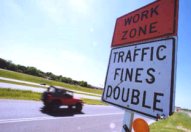10/24/2005
Transportation Officials Using Bogus Worker Death DataInflated worker death numbers used to implement double fine programs that have no proven beneficial safety effect.

Citing an alarming number of deaths that occur in highway work zones, twenty-six states have adopted legislation that doubles the amount of traffic fines in work zones. Nearly all of the remaining states impose surcharges and other substantial monetary penalties, generally without regard to whether workers are actually present at the time of the offense. There is reason, however, to question the stated rationale behind the increased fines.
In July, for example, New York Governor George E. Pataki announced a new $50 surcharge for work zone speeding on top of the already doubled fine and a 60-day license suspension for a second offense.
"Although work zone accident fatalities are rare, a total of 467 traffic crashes were reported in New York State Department of Transportation work zones in 2004, with seven crashes resulting in fatalities," Pataki's announcement states, leading one to believe that reckless motorists in speeding automobiles had killed seven workmen.
According to a 2001 study from the Centers for Disease Control and Prevention, however, automobiles accounted for only 15 percent of highway construction accidents involving an injury. Trucks were the primary cause of injury in 45 percent of cases and road grading and surfacing equipment caused 15 percent of injuries. Construction machines caused 53 percent of fatalities and trucks caused 26 percent. (View full study, 436k PDF format.)
This means that many accidents classified as "work zone related" in National Highway Traffic Safety Administration statistics include instances where, for example, a dump truck backs over a worker or an asphalt steam roller hits a worker (examples). That's why the National Transportation Safety Board recommended in 1992 that, "the reporting of work zone fatalities should be revised to distinguish between persons driving highway maintenance vehicles within work zones and other drivers who crash in work zones while traversing the work zone site."
Studies show that regardless of the rationale, double fines have not shown significant safety benefits. The Texas Transportation Institute investigated the effect of a 1998 double fine law in Texas and concluded, "The studies indicated that the double-fine law had little effect on traffic speed characteristics in the work zones examined." (View summary, 849k PDF format.)
This year, two out of three doubled fine zones in New Jersey experienced an increase, not a decrease, in accidents according to one analysis.
"When you clear away the slogans, 'Give 'em a brake' is not about worker safety," Patrick Bedard concludes after examining the issue in the November issue of Car & Driver. "It's about government agencies spending money and raising more."


